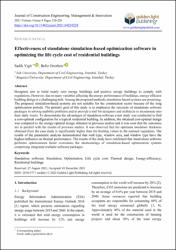| dc.contributor.author | Yiğit, Sadık | en_US |
| dc.contributor.author | Ozorhon, Beliz | en_US |
| dc.date.accessioned | 2022-09-30T11:48:20Z | |
| dc.date.available | 2022-09-30T11:48:20Z | |
| dc.date.issued | 2021-12 | |
| dc.identifier.citation | Yiğit, S. & Ozorhon, B. (2021). Effectiveness of standalone simulation-based optimization software in optimizing the life cycle cost of residential buildings. Journal of Construction Engineering, Management & Innovation, 4(4), 210-228. doi:10.31462/jcemi.2021.04210228 | en_US |
| dc.identifier.issn | 2630-5771 | en_US |
| dc.identifier.uri | https://hdl.handle.net/11729/4926 | |
| dc.identifier.uri | http://dx.doi.org/10.31462/jcemi.2021.04210228 | |
| dc.identifier.uri | https://search.trdizin.gov.tr/yayin/detay/509409 | |
| dc.description.abstract | Designers aim to build nearly zero energy buildings and positive energy buildings to comply with regulations. However, due to many variables affecting the energy performance of buildings, energy-efficient building design is a challenging task. Among the proposed methods, simulation-based systems are promising. The proposed simulation-based systems are not suitable for the construction sector because of the long optimization periods. The primary goal of this study is to emphasize the necessity of standalone software packages in solving usability problems and to provide a tool for designers and architects to incorporate into their daily works. To demonstrate the advantages of standalone software a test study was conducted to find a cost-optimal configuration for a typical residential building. In addition, the obtained cost-optimal design was compared to the energy-optimal design obtained in previous studies and it was seen that the outcomes are in parallel with the results of previous studies. It was observed that the optimum insulation thickness obtained from the case study is significantly higher than the limiting values in the national regulation. The results of the parametric analysis demonstrated that wall type, window area, and window type have the highest influence on thermal performance. The results of the study have confirmed that stand-alone software performs optimizations faster overcomes the shortcomings of simulation-based optimization systems comprising integrated multiple software packages. | en_US |
| dc.language.iso | en | en_US |
| dc.publisher | Dynamic Academy Yazılım İnşaat San. Tic. Ltd. Şti. | en_US |
| dc.relation.ispartof | Journal of Construction Engineering, Management & Innovation | en_US |
| dc.rights | info:eu-repo/semantics/openAccess | en_US |
| dc.subject | Standalone software | en_US |
| dc.subject | Simulation | en_US |
| dc.subject | Optimization | en_US |
| dc.subject | Life cycle cost | en_US |
| dc.subject | Thermal design | en_US |
| dc.subject | Energy-efficiency | en_US |
| dc.subject | Residential buildings | en_US |
| dc.title | Effectiveness of standalone simulation-based optimization software in optimizing the life cycle cost of residential buildings | en_US |
| dc.type | Article | en_US |
| dc.description.version | Publisher's Version | en_US |
| dc.department | Işık Üniversitesi, Mühendislik ve Doğa Bilimleri Fakültesi, İnşaat Mühendisliği Bölümü | en_US |
| dc.department | Işık University, Faculty of Engineering and Natural Sciences, Department of Civil Engineering | en_US |
| dc.authorid | 0000-0002-6257-1306 | |
| dc.authorid | 0000-0002-6257-1306 | en_US |
| dc.identifier.volume | 4 | |
| dc.identifier.issue | 4 | |
| dc.identifier.startpage | 210 | |
| dc.identifier.endpage | 228 | |
| dc.peerreviewed | Yes | en_US |
| dc.publicationstatus | Published | en_US |
| dc.relation.publicationcategory | Makale - Ulusal Hakemli Dergi - Kurum Öğretim Elemanı | en_US |
| dc.institutionauthor | Yiğit, Sadık | en_US |
| dc.indekslendigikaynak | TR-Dizin | en_US |


















